| 1 | Red-necked keelback |
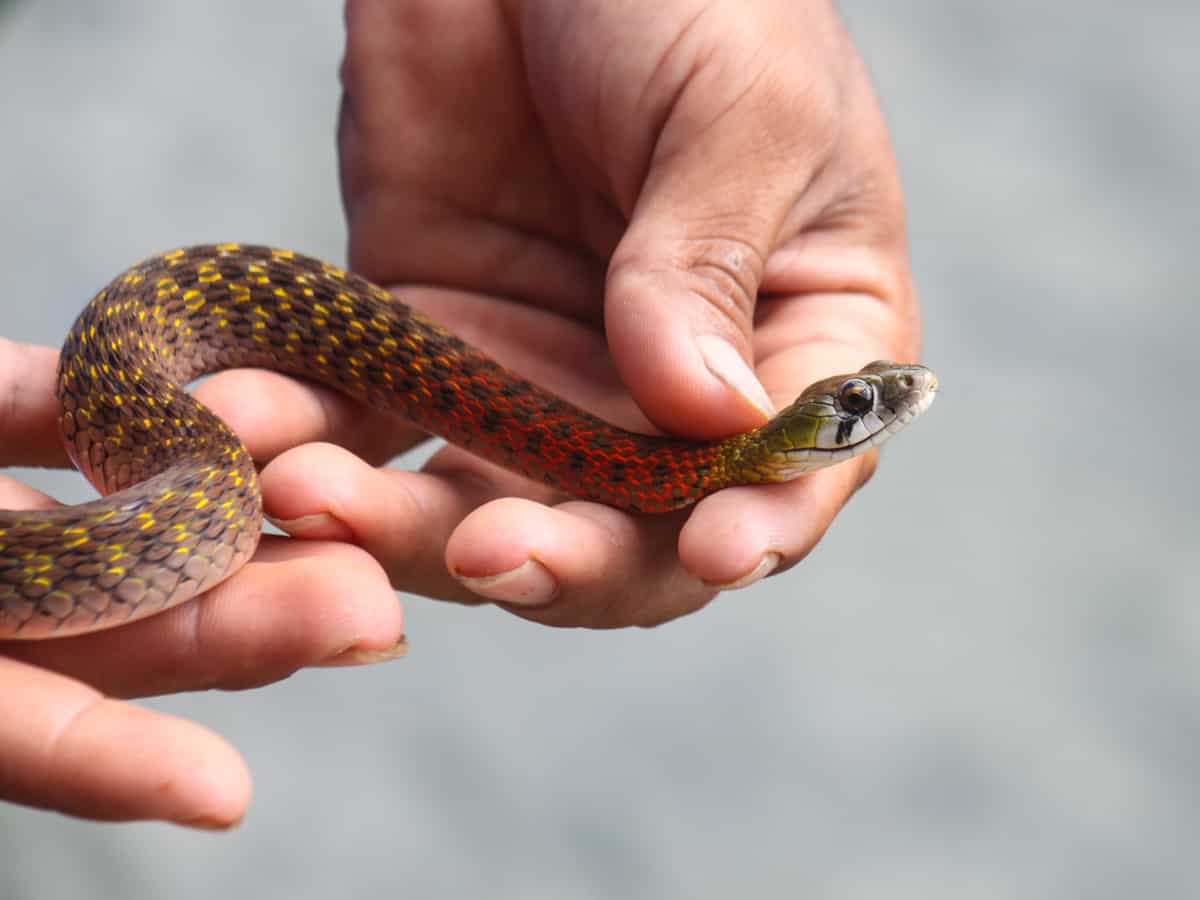
Length: 60-80cm.
Rhabdophis is a venomous family of snakes with 31 members as of 2023, which ranges from India through Thailand to most of Indonesia. The red-necked keelback is the most abundant, and best studied of all. It primarily eats amphibians like the four-lined tree frog, and its venom can trigger kidney failure. It stays close to water bodies, including forest streams, and drainage ditches in towns near Bangkok. But this species has one shocking feature above all else.
Red-necked keelbacks are immune to the deadly bufanolides secreted by toads. Other snakes would drop dead, but Rhabdophis siamensis feasts on them greedily, even while the toad desperately releases a white poisonous froth down its back. Most importantly though, red-necked keelbacks sequester these toad toxins for defensive purposes. They store them in a nuchal gland located in their neck, with parallel nuchal ducts that burst upon contact, or when a red-necked keelback triggers it, possibly with a flex of their own neck muscles. This is used to ward off predators, and the toad toxins are stored in the signature red neck.
Other family members possess these nuchal glands as well. Red-necked keelbacks inhabit virtually all of Thailand, and a swathe of southeast Asia. They inhabit the water channels of Hong Kong, and reach as far west as northeast India.
| 2 | Tiger keelback |
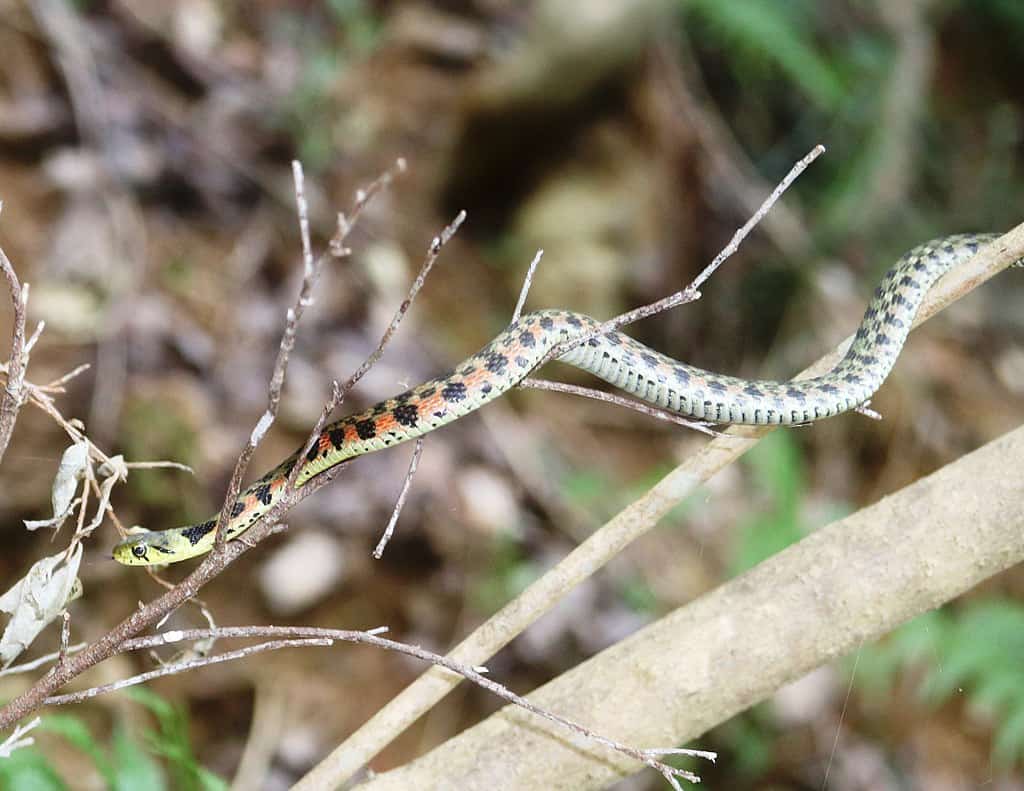
Length: 50-115cm.
The Japanese Rhabdophis member. Tiger keelbacks also inhabit South Korea, southeast China and Taiwan, making them the easternmost Rhabdophis member overall, as well as the most northerly. Tiger keelbacks possess the same diabolical nuchal glands as the red-neck. This time, it’s Japanese common toads (Bufo japonicus) which they steal bufotoxins from, as a natural part of their diet. As with red-necked keelbacks, they’re capable of releasing them from their neck, in a lethal white froth.
Tiger keelbacks also possess a nasty venom. While only 5 Japanese people died from 1971 to 2000, a bite can trigger disseminated intravascular coagulation, when numerous small clots suddenly form. The bite specialises in kidney failure, with a rate of 40% without antivenom (which reduced the rate to 5.3%). Bites are particularly common in the west of Honshu, Japan’s main island.
Amphibians are their main prey, and confirmed meals include Japanese tree frogs, and Bankor toads in Taiwan. A tiger keelback’s top habitats are streams within forests, with plenty of grass, though in the summer, they tend to move further from these streams. Watch out, as like red-necked keelbacks, tiger keelbacks can fire their toad poison stash through mid-air, striking people in the eye at distances of 1 metre.
| 3 | Blue-necked keelback |
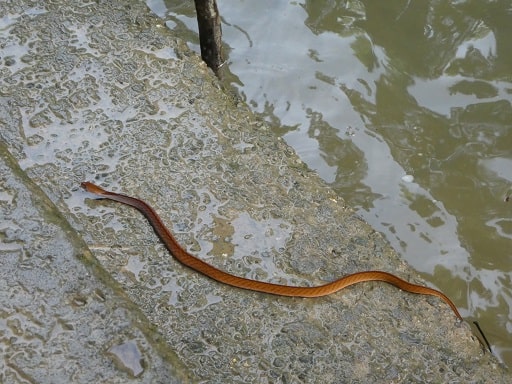
Length: 35-75cm.
A rarely sighted snake, which is most common in streams in evergreen forests. Blue-necked keelbacks (Rhabdophis rhodomelas) only inhabit far southern Thailand, but inhabit both peninsular and mainland Malaysia, Singapore, Sumatra and Java. While the blue neck is real, a more consistent ID sign is a vivid black spinal stripe, contrasting against an orange body. A subtler ID sign (used by scientists) is 126-136 belly scales, one of the least of the family.
Blue-necked keelbacks have never killed anybody on record, but a 2004 victim experienced muscular weakness, slurred speech, a cold sweat, faintness, and laboured breathing. This was the first ever detailed bite report. They possess the ability to store toad toxins in their nuchal glands, ready to burst in people’s faces. A Mr H. N. Ridley made one of the first observations of this. Ridley watched the keelback flatten its neck, and exude a mysterious white dribble of liquid. His dog bit the snake, and white froth poured from its mouth like it had just bitten a poisonous toad.
Blue-necked keelbacks prey on amphibians, as usual, and one observation happened in Singapore’s Central Catchment Nature Reserve, along the Terentang trail. The victim was a common Asian toad (Duttaphrynus melanostictus), and the snake sank its fangs into the toad’s mid-section, leaving a bloody red mark. This happened in a thick bed of leaf litter. The keelback spent 10 minutes chewing on the toad, which tried frantically to break free. The keelback dragged the toad away from the path, but gave up due to disturbances from joggers and the scientists. Anther confirmed place to find them is the Ula Muda forest of northern Malaysia.
| 4 | Black-banded keelback |
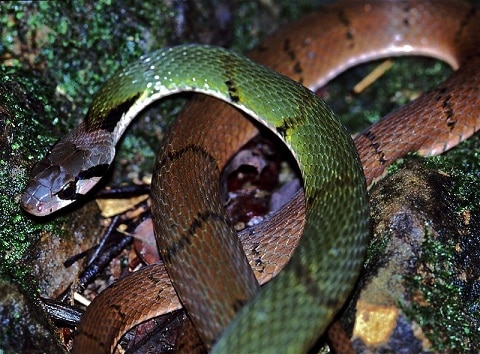
Length: up to 100cm.
Another Thai keelback, and another one capable of storing toad bufotoxins, which was first confirmed back in 1938. Black-banded keelbacks inhabit most of Thailand except the extreme south. They also cross the borders of Laos to the north, Cambodia to the east, and Myanmar to the west, but their territory is centred around Thailand. This is a much more northerly species than the blue-necked keelback.
Rhabdophis nigrocinctus is rarely seen, sticking to obscure jungle streams, rather than towns and cities. This is a poorly researched species, and the strength of their venom is unknown. However, black-banded keelbacks eat the usual amphibian diet. In March 2017, in a pebbled stream in Kham-mouane province of central Laos, scientists found a black-banded keelback grasping an Asian rice frog (Fejervarya limnocharis) by its hind legs and lower body. Within 3 minutes, the snake had fully swallowed the frog from the legs upwards. Asian rice frogs are also confirmed prey of oriental ratsnakes and painted bronzebacks, so the black-banded keelback has competition for its food sources.
Another food chain player is the king cobra, which was witnessed eating a black-banded keelback in 2006, despite its corrosive venom. The cobra slithered off, and whether it survived was unknown.
| 5 | White-lined water snake |
Length: 40-60cm.
The resident keelback of the Philippines, including near Davao City. Rhabdophis auriculata is found nowhere outside the Philippines, and is the only member of this list to occur on Luzon, the largest Phillipine island.
White-lined watersnakes have virtually no research, and it’s unknown whether they sequester toad toxins in a nuchal gland like their cousins. They’re confirmed to inhabit the forests surrounding Mount Malindang, and are plentiful in Mt. Kalatungan Range Natural Park. They range from 75 to 2100 metres above sea level, with their highest locations being near Mount Apo. A study from the Mt. Hamiguitan Range found several white-striped watersnakes, but categorised them as “rare”. They were mainly found in creeks and on low-lying vegetation.
Rhabdophis auriculata is recognisable by white stripes on the side of their body, and intermittent white spots between these stripes. The area inbetween is dark brown. This white-brown colour scheme extends to their head, which has intricate patterns. The most colourful body part is their belly, which is aqua blue with an electric blue spot in the centre of each scale. But few will notice this splash of colour.
| 6 | Speckle-bellied keelback |
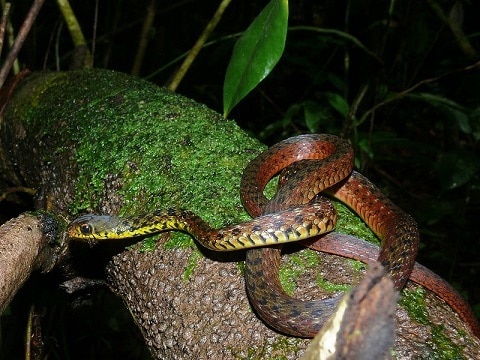
Length: 60-95cm.
The first of this list which is confirmed not to sequester toad toxins in nuchal glands, lacking the awesome power of their cousins. Speckle-bellied keelbacks are widespread, inhabiting all of Thailand except the east. They inhabit peninsular and mainland Malaysia, Sumatra, Java, and also reach Palawan, the Philippines’ westernmost island. As you can see from the image, they have one of the most jungled appearances, like pure rainforest spawn; there’s no way you’d find Rhabdophis chrysargos in the Mojave desert.
Speckle-bellied keelbacks are found near streams in forests, but also manmade canals through sugar plantations in Thailand. In December 2015, in Pahang province, peninsular Malaysia, scientists came across a venomous Siamese peninsular pitviper (Trimeresurus fucatus) swallowing a fellow snake, whose tail was just disappearing. The scientists moved the pitviper to vegetation adjacent to the road, when suddenly, it regurgitated its meal, allowing them to make an ID. It was a speckle-bellied keelback, thus confirming that this species is hunted by fellow venomous snakes in the wild.
Meanwhile, their own prey include the Philippine toad (Ingerophrynus philippinicus), observed in 2017, which was their first frog meal to be confirmed to the species level. In a 2018 observation from Thailand, a speckle-bellied keelback ate a green paddy frog (Hylarana erythraea), taking 7 minutes from start to finish.
| 7 | Taiwan keelback |
Length: at least 60cm.
This species is found exclusively on Taiwan. In fact, it was the first ever endemic snake species described from Taiwan. Taiwan keelbacks are one of the dullest members, with grey scales like a grass snake, albeit with contrasting cream-black colours around their neck.
Whether this species can store toad toxins is a mystery. A 1999 study reported that the nuchal glands were missing, but a 2009 study noted that they were present. A brown dribble of liquid has been reported to spew from their neck when harassed, and they’ve been witnessed widening their neck to create an illusion of size.
Taiwan keelbacks are described as a docile species which hardly ever bites, which stays close to forest floors and areas of high humidity. Their diet may be slightly different, as the first official observation happened in 2006, when a Taiwan keelback was spotted by the side of the trail in Yunlin County eating a large earthworm. However, they’ve been mentioned to eat their old frog staples as well.
| 8 | Indian green keelback |
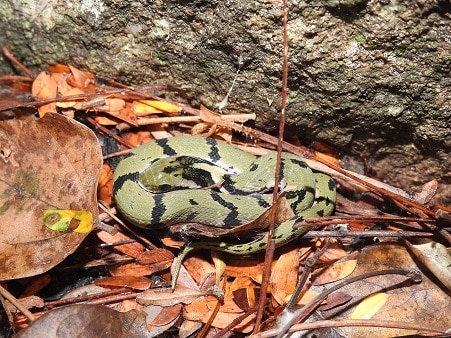
Length: 50-60cm.
Rhabdophis plumbicolor is the westernmost species on our list. You won’t find them in Thailand, Malaysia or Indonesia. This species inhabits about two thirds of India, skipping the northwest and towering Himalaya. They also cross into Bangladesh over the northeastern border, and Sri Lanka to the south. Their ability to flatten their neck is extreme; just check out this image of a Sri Lankan individual. Unlike a cobra, they keep their widened neck to the ground rather than upright.
Rhabdophis plumbicolor possesses the nuchal glands which allow them to spray sequestered toad toxins in your face. This was confirmed in 1938, and more recently in 2016. Green keelbacks have a variety of defensive tricks: kinking its body to resemble vegetation, faking death by flipping onto its back, hissing loudly, and vibrating its tail loudly.
Green keelbacks are fairly easy to recognise. While the local pitvipers are equally green, Rhabhopis plumbicolor is commonly adorned with intermittent black bars. However, these are sometimes missing, and there’s weird morphs around, like this fully blue version discovered in 2020 in Maharasthra state. No species are confirmed, but green keelbacks are known to feed on frogs.
| 9 | Sahul keelback |
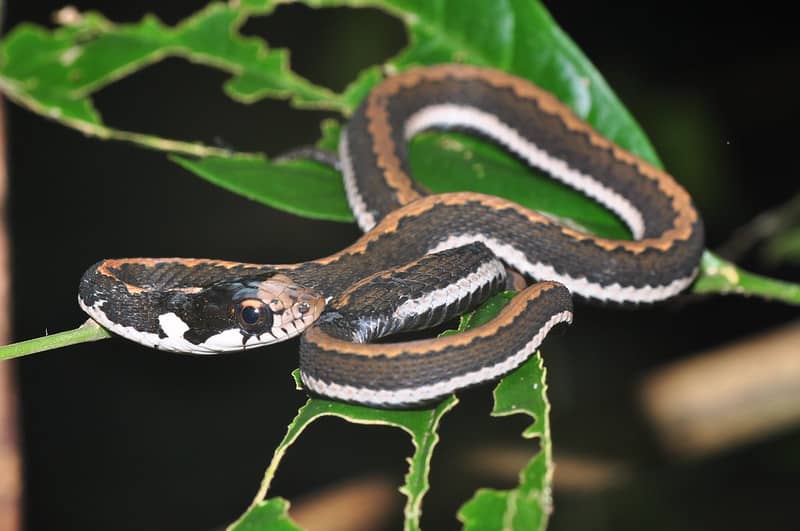
Length: 50-70cm (maximum 87cm).
Also known as Günther’s keelback, this is found mainly in the Sulawesi islands of Indonesia, and in parts of Java. Most of our list could do with more research, but Sahul keelback takes the cake for mystery. The first unknown characteristic is the nuchal glands, whether they can sequester toad toxins. Their actual venom is completely mysterious, and no detailed bite reports exist.
Most our information is gleamed from photos, such as Sahul keelbacks sitting on a large rainforest leaf, or coiled around a thin branch. This is a high contrast snake rather than a dull one. Rhabdophis chrysargoides has colours that almost look like dabs of a paintbrush, with black sides and a wavy red vertebral stripe. But there’s also a handful which are plainer, with a brick red colour. One of the technical ID methods is 164-171 belly (ventral) scales.
This species likes rainforest with a high canopy cover (90% coverage), where they drape themselves over branches 1 metre above a shallow stream, or rest on the edges of the stream. One of its hotspots is Button Island, South Sulawesi, where it’s commonly found near water. While Java is listed as a location, the vast majority of sightings have been on Sulawesi. Indonesia is the only nation they’re confirmed to inhabit.
| 10 | Bindee keelback |
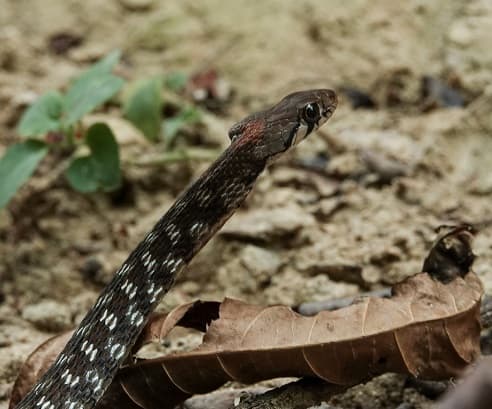
Length: 60-80cm.
A completely new species, made official only in 2021. The Bindee keelback (Rhabdophis bindi) was discovered while scientist Abhijit Das surveyed the Barail Hill Range of Cachal District, northeast India. Its mixture of grey, white speckles and bulging eyes looked different to snakes he normally encountered there, and genetic analysis confirmed its independent status.
The Bindee keelback had previously been sighted in Bangladesh, but falsely attributed to the Himalayan keelback species, which is actually the Bindee keelback’s closest relative. Himalayan keelbacks are found only in mountainous areas, while Bindee keelbacks prefer lowland forests. The very first study discovered a lack of nuchal glands (unlike the Himalayan version), so there’s no toad toxin threat with this species.
Bindee keelbacks measure 60-80cm, and were named for a distinctive red spot on their neck which resembles the “bindi” marking found on some Indian women’s foreheads. Das had found the first snake in 2007, before finding ten more, all below 100 metres in altitude. It then took 14 years to conduct thorough genetic analysis. The original Bindee keelback was found near a small evergreen forest stream.
